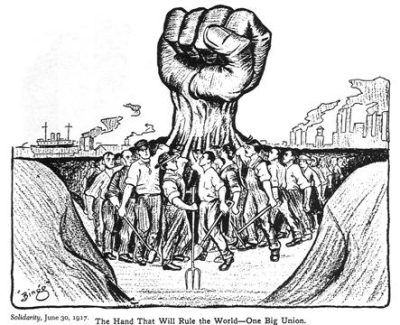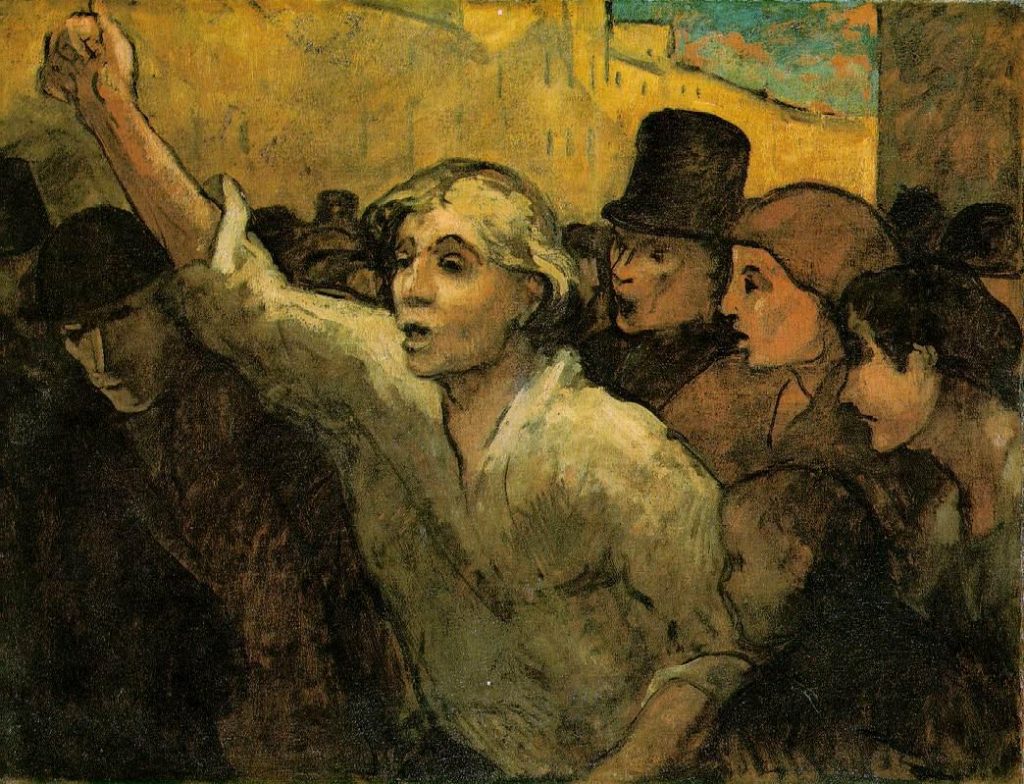Captain Rock: The Symbol of a Risen People. Paintings and the History of Irish Resistance

All Global Research articles can be read in 51 languages by activating the Translate Website button below the author’s name.
To receive Global Research’s Daily Newsletter (selected articles), click here.
Click the share button above to email/forward this article to your friends and colleagues. Follow us on Instagram and Twitter and subscribe to our Telegram Channel. Feel free to repost and share widely Global Research articles.
***
“My unlucky countrymen have always had a taste for justice, a taste as inconvenient to them, situated as they always have been, as a fancy for horse-racing would be to a Venetian.” —Thomas Moore (1779–1852) – Memoirs of Captain Rock: The Celebrated Irish Chieftain, with Some Account of His Ancestors (1824)
The raised or clenched fist is a symbol of unity and solidarity that became associated with trade unionism and the labour movement going back to the 1910s in Europe and the USA. Soon after, it was taken up as a symbol of political unity by socialist, communist and various other revolutionary social movements. The clenched fist is ever more powerful than the individual fingers and in art it has been used as a metaphor for strength in unity of the peoples’ movements.
The painting, Le Soulèvement (The Uprising) by Honoré Daumier (1808–1879) of the French Revolution of 1848 includes a possible early example of a “political clenched fist,” according to curator Francesca Seravalle. She writes:
“A raised fist appeared for the first time as a political sign in a painting in 1848 by Daumier representing a woman during the Third French Revolution, until that time fists were just expressions of human nature.”
Le Soulèvement (The Uprising) by Honoré Daumier
However, another painting, The Installation of Captain Rock (1834), by the Irish artist Daniel Maclise (1806–1870) in the National Gallery of Ireland, depicts the protagonist with a raised, clenched fist as a political sign fourteen years earlier than Daumier’s revolutionary painting, surely demonstrating that the depth of oppression of colonialism in Ireland had already produced self-conscious radical political groups.
Captain Rock was a fictitious figure that was associated with the militant agrarian organisations in Ireland known as “the ‘Whiteboys’, the ‘Ribbonmen’, and the followers of ‘Captain Steel’ or ‘Captain Right'”.
The Installation of Captain Rock (1834) by Daniel Maclise (1806–1870)
These agrarian groups “issued warnings of violent reprisals against landlords and their agents who tried to arbitrarily put up rents, collectors of tithes for the Anglican Church of Ireland, government magistrates who tried to evict tenants, and informers who fingered out Rockites to the authorities,” and involved many incidents of murder, arson, beatings and mutilation of cattle.
The source of the unrest was the hunger and death suffered by Irish families while their landlords shipped harvests and cattle to the English markets. Peter Berresford Ellis writes:
“This was the cause of the agrarian unrest among the rural population. Indeed, in 1822 a major artificial famine was about to occur. We have William Cobbett’s horrendous picture of people starving in the midst of plenty in that year. In June, 1822, in Cork alone, 122,000 were on the verge of starvation and existing on charity. How many people died is hard to say. A minimum figure of 100,000 has been proposed. Most likely around 250,000. At the same time, landowners were able to ship 7 million pounds (weight) of grain and countless herds of cattle, sheep and swine to the markets in England.”
Captain Rock’s Banditti – Swearing in a new member.
Insurrections occurred in 1822 that involved many thousands of ‘Rockites’ that had armed themselves with pikes and confronted British garrisons. According to Berresford Ellis:
“Colonel James Barry, commanding the garrison at Millstreet, reported that upwards of 5,000 ‘rebels’ had surrounded the town and many houses of loyalists between Inchigeelagh and Macroom were destroyed. The local Millstreet magistrate, E McCarty, added: ‘The people are all risen with what arms they possess and crown all the heights close to the town …’ Cork City and Tralee were cut off for two days before troops fought their way through.”
‘Captain Rock’ had already made it into Irish literary history in the fictitious book, Memoirs of Captain Rock: The Celebrated Irish Chieftain, with Some Account of His Ancestors (1824) written by the Irish writer, poet, and lyricist Thomas Moore (1779–1852). In these ‘memoirs’ Captain Rock is depicted in a folkloric way, a character who brushes off lightly the dangers of his profession, as he states:
“Discord is, indeed, our natural element ; like that storm-loving animal, the seal, we are comfortable only in a tempest; and the object of the following historical and biographical sketch is to show how kindly the English government has at all times consulted our taste in this particular ministering to our love of riot through every successive reign, from the invasion of Henry II. down to the present day, so as to leave scarcely an interval during the whole six hundred years in which the Captain Rock for the time might not exclaim
“Quae regio in terris nostri non plena laboris?”
or, as it has been translated by one of my family : —
Through Leinster, Ulster, Connaught, Munster, Rock ‘s the boy to make the fun stir!”
Similar comparisons can be made with the contemporary Kenyan author, Ngũgĩ wa Thiong’o, who combines social realism of contemporary society with mythical elements as a way of illustrating his radical themes, for example in Devil on the Cross (1980), Jacinta Wariinga, is invited to a Devil’s Feast by a mysterious figure called Munti that turns out to be a business meeting for the Organization for Modern Theft and Robbery.
Image: Devil on the Cross (1980) by Ngũgĩ wa Thiong’o
The high educational level of ‘Captain Rock’ is attributed to his associations with the teachers of the Irish ‘hedge schools’, which were small informal secret and illegal schools set up in the eighteenth and nineteenth century to provide primary education to children of ‘non-conforming’ Catholic and Presbyterian faiths.
According to Maeve Casserly, “the hedge schoolmaster played a pivotal role, as both an educator and prominent member in agrarian society, in encouraging the militant political and social sentiments” and that “in an age which promoted the utilitarian philosophy of Jeremy Bentham and emphasised ‘useful learning’ that subjects like Greek, Latin and Hebrew, which formed an intrinsic part of the hedge school curriculum, were wastefully taught instead of necessary vocation skills.” To direct attention away from their militant leadership roles, the hedge schoolmasters used poor grammar and mis-spelled words. She notes that “William Carleton was of a similar opinion that many of the letters, oaths and catechisms of the Rockite insurrectionists, were the work of village schoolmasters.”
Thus, the very public ‘Installation of Captain Rock’ in Maclise’s painting points to the symbolism of the patriotic movement rather than its reality. The clenched fist represents not only the unity of the gathered crowd but also the passing of responsibility for radical social and political change from the deceased elder leader to the vigorous, radical youth.
A depiction of a 19th century hedge school.
In the painting Maclise depicts the scene as a joyous occasion within a hall where many groups of ordinary people are busy getting on with life, yet plotting revolution. To the left a group is making a pact signified by their collective hand grasp, while behind them in a dark alcove appears to be a hedge school master surrounded by listeners and readers. To the right of the hall there is much merriment as a man and a woman dance wildly. Our eyes are drawn around a distracting group of young lovers as we suddenly realise that a gun is being pointed right at us by a young man in front who is just about to shoot (signified by a girl putting her hands to her ears), demonstrating that youthful ‘fun’ should never be underestimated and can suddenly turn deadly serious.
The background to Maclise’s painting looks more like a group of people digging their way down to the hall where the secret ceremony is taking place. This signifies the working class aspect of the dangers of mining work (often carried out by children in the nineteenth century), as well as the necessity for literal and metaphorical underground bunkers to hide from the often overwhelming force of the oppressor.
Overall, the people in the painting are portrayed as active, animated, excited, and fearless.
Image: 1857 lithograph of Daniel Maclise by Charles Baugniet
Maclise excelled in paintings of large groups of people engaged in various activities grouped around a theme. Maclise had an ongoing interest in the ideology, history, and traditions of ordinary people as can be seen in the subject matter of some of his paintings, for example, Snap-Apple Night (1833) [Hallowe’en traditions], Merry Christmas in the Baron’s Hall (1838) [containing many figures of various ranks and degrees and depicts aspects of the declining traditional Christmas festivities of his time, see my article A Poem for Christmas: Christmas Revels (1838)], The Marriage of Strongbow and Aoife (1854) [depiction of the Norman conquest of Ireland and the death of Gaelic Ireland].
Maclise’s positive portrayal of people is in contrast with the often melancholy depictions of oppressed people around the world, an unfortunate side effect of Social Realism which tried to show the treatment of the poor in all its brutality. However, depictions of the moment of uprising also sows the seeds of hope for a better future, while at the same time providing a fair warning to all elites to beware of the retaliation of a community which has nothing left to lose.
Note to readers: Please click the share button above. Follow us on Instagram and Twitter and subscribe to our Telegram Channel. Feel free to repost and share widely Global Research articles.
Caoimhghin Ó Croidheáin is an Irish artist, lecturer and writer. His artwork consists of paintings based on contemporary geopolitical themes as well as Irish history and cityscapes of Dublin. His blog of critical writing based on cinema, art and politics along with research on a database of Realist and Social Realist art from around the world can be viewed country by country here. Caoimhghin has just published his new book – Against Romanticism: From Enlightenment to Enfrightenment and the Culture of Slavery, which looks at philosophy, politics and the history of 10 different art forms arguing that Romanticism is dominating modern culture to the detriment of Enlightenment ideals. It is available on Amazon (amazon.co.uk) and the info page is here.He is a Research Associate of the Centre for Research on Globalization (CRG).
Featured image: Ralph Chaplin – Cartoon published in the Industrial Workers of the World (IWW) journal Solidarity on June 30, 1917.







